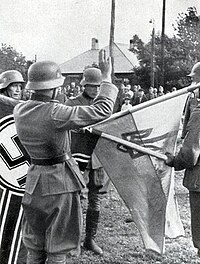

Among the approximately one million foreign volunteers and conscripts who served in the Wehrmacht during World War II were ethnic Belgians, Czechs, Dutch, Finns, Danes, French, Hungarians, Norwegians, Poles,[1] Portuguese, Swedes,[2] Swiss along with people from Great Britain, Ireland, Estonia, Latvia, Lithuania, and the Balkans.[3] At least 47,000 Spaniards served in the Blue Division.[4]
Some estimates state anywhere between 600,000 and 1,400,000 Soviet citizens (Russians and other non-Russian ethnic minorities) joined the Wehrmacht forces as Hiwis (or Hilfswillige).[5] The Ukrainian collaborationist forces were composed of an estimated number of 180,000 volunteers serving with units scattered all over Europe.[6] Russian émigrés and defectors from the Soviet Union formed the Russian Liberation Army or fought as Hilfswillige within German units of the Wehrmacht primarily on the Eastern Front.[7] Non-Russians from the Soviet Union formed the Ostlegionen (literally "Eastern Legions"). The East Legions comprized a total of 175,000 personnel.[8] These units were all commanded by General Ernst August Köstring (1876−1953).[9] A lower estimate for the total number of foreign volunteers that served in the entire German armed forces (including the Waffen SS) is 350,000.[10]
These units were often under the command of German officers and some published their own propaganda newssheets.


